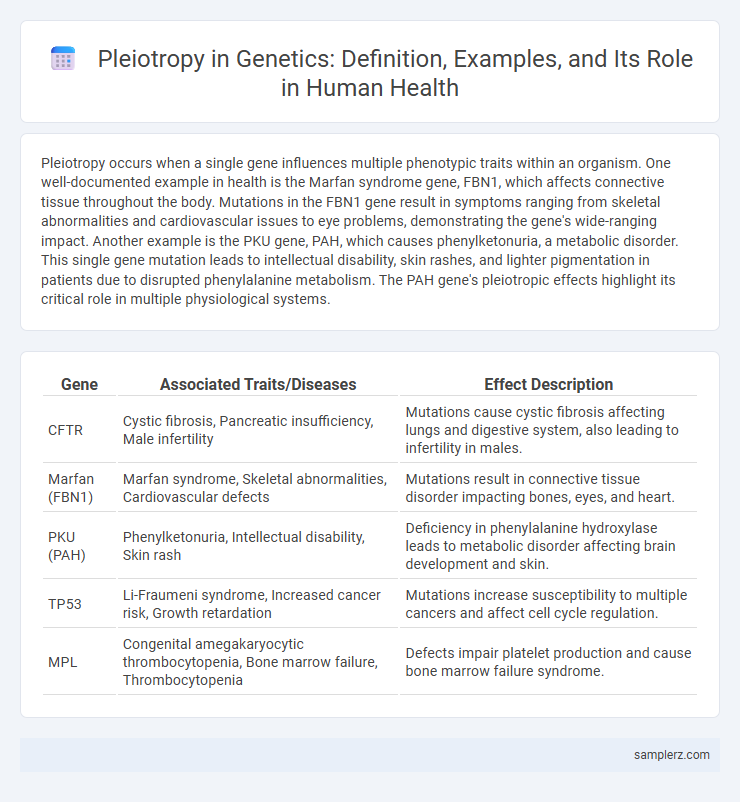Pleiotropy occurs when a single gene influences multiple phenotypic traits within an organism. One well-documented example in health is the Marfan syndrome gene, FBN1, which affects connective tissue throughout the body. Mutations in the FBN1 gene result in symptoms ranging from skeletal abnormalities and cardiovascular issues to eye problems, demonstrating the gene's wide-ranging impact. Another example is the PKU gene, PAH, which causes phenylketonuria, a metabolic disorder. This single gene mutation leads to intellectual disability, skin rashes, and lighter pigmentation in patients due to disrupted phenylalanine metabolism. The PAH gene's pleiotropic effects highlight its critical role in multiple physiological systems.
Table of Comparison
| Gene | Associated Traits/Diseases | Effect Description |
|---|---|---|
| CFTR | Cystic fibrosis, Pancreatic insufficiency, Male infertility | Mutations cause cystic fibrosis affecting lungs and digestive system, also leading to infertility in males. |
| Marfan (FBN1) | Marfan syndrome, Skeletal abnormalities, Cardiovascular defects | Mutations result in connective tissue disorder impacting bones, eyes, and heart. |
| PKU (PAH) | Phenylketonuria, Intellectual disability, Skin rash | Deficiency in phenylalanine hydroxylase leads to metabolic disorder affecting brain development and skin. |
| TP53 | Li-Fraumeni syndrome, Increased cancer risk, Growth retardation | Mutations increase susceptibility to multiple cancers and affect cell cycle regulation. |
| MPL | Congenital amegakaryocytic thrombocytopenia, Bone marrow failure, Thrombocytopenia | Defects impair platelet production and cause bone marrow failure syndrome. |
Understanding Pleiotropy: Key Concepts in Genetics
Pleiotropy occurs when a single gene influences multiple, seemingly unrelated phenotypic traits, such as how the Marfan syndrome gene (FBN1) affects connective tissue in the eyes, heart, and skeletal system. This phenomenon highlights the complexity of genetic architecture and the interconnectedness of biological pathways in human health. Studying pleiotropy improves understanding of genetic disorders and aids in developing targeted therapies by revealing how one mutation can have diverse clinical manifestations.
Classic Examples of Pleiotropic Genes in Humans
The Marfan syndrome gene FBN1 exemplifies pleiotropy by affecting connective tissue integrity, leading to symptoms in the cardiovascular, skeletal, and ocular systems. The cystic fibrosis transmembrane conductance regulator (CFTR) gene mutation causes cystic fibrosis, impacting the lungs, pancreas, and sweat glands simultaneously. Another classic pleiotropic gene is the PKU gene (PAH), where mutations result in phenylketonuria, affecting neurological development and skin pigmentation.
Marfan Syndrome: A Case of Pleiotropy in Connective Tissue
Marfan Syndrome exemplifies pleiotropy by stemming from mutations in the FBN1 gene, which encodes fibrillin-1, a crucial protein in connective tissue. These mutations cause diverse symptoms affecting multiple systems, including the cardiovascular system with aortic aneurysm risk, the skeletal system with elongated limbs, and ocular issues such as lens dislocation. Understanding the pleiotropic effects of FBN1 mutations aids in diagnosing and managing Marfan Syndrome across its varied clinical presentations.
Sickle Cell Anemia: Multiple Effects of a Single Gene Mutation
The single gene mutation in the HBB gene responsible for Sickle Cell Anemia demonstrates pleiotropy by causing abnormal hemoglobin structure, leading to distorted red blood cells that impair oxygen transport. This mutation results in multiple clinical manifestations, including anemia, pain crises, and increased susceptibility to infections. The diverse symptoms highlight the broad physiological impact of a single genetic alteration on the body's systems.
Phenylketonuria (PKU): Diverse Manifestations from One Gene
Phenylketonuria (PKU) illustrates pleiotropy where mutations in the PAH gene cause a spectrum of health issues including intellectual disability, seizures, and skin disorders. The PAH gene mutation leads to deficient phenylalanine hydroxylase enzyme activity, resulting in toxic accumulation of phenylalanine in the brain. Early diagnosis and dietary management are critical to prevent neurological damage and other systemic complications linked to this single gene defect.
The Impact of Pleiotropy on Drug Response and Side Effects
Pleiotropy occurs when a single gene influences multiple physiological traits, which significantly impacts drug response and side effects. For instance, the CYP2C19 gene affects the metabolism of several drugs including clopidogrel and proton pump inhibitors, leading to variable therapeutic outcomes and adverse reactions. Understanding pleiotropic effects helps in personalizing treatment plans to optimize efficacy and minimize harmful side effects in patients.
Pleiotropy in Metabolic Disorders: Insights from Genetic Studies
Pleiotropy in metabolic disorders is exemplified by the FTO gene, which influences both obesity and type 2 diabetes risk through its regulation of energy homeostasis and fat mass. Genetic studies reveal that variants in the FTO gene affect metabolic pathways leading to insulin resistance and increased adiposity, highlighting its multifaceted role in disease development. Understanding pleiotropic effects in genes like FTO aids in identifying targets for therapeutic interventions in complex metabolic conditions.
Neurological Examples of Pleiotropy: Genes Affecting Multiple Systems
The APOE gene exemplifies pleiotropy by influencing both lipid metabolism and neurological health, significantly affecting Alzheimer's disease risk and cardiovascular outcomes. Mutations in the SCN1A gene impact ion channels in neurons, leading to epilepsy and additional neurological disorders such as migraine and ataxia. These genes demonstrate how single genetic variations can have widespread effects across multiple biological systems, complicating diagnosis and treatment in neurological conditions.
Pleiotropy’s Role in Complex Diseases: Implications for Health
Pleiotropy occurs when a single gene influences multiple phenotypic traits, playing a crucial role in the development of complex diseases such as diabetes, cardiovascular disorders, and schizophrenia. The APOE gene, for example, is pleiotropic, affecting both cholesterol metabolism and Alzheimer's disease risk, highlighting how gene variants contribute to diverse health outcomes. Understanding pleiotropy improves disease prediction models and informs targeted therapies by revealing genetic pathways impacting multiple physiological systems.
Challenges and Opportunities in Studying Pleiotropic Genes in Medicine
Pleiotropic genes, such as the CFTR gene implicated in cystic fibrosis and pancreatic disorders, present significant challenges in medical research due to their involvement in diverse phenotypic expressions. Studying these genes requires advanced genomic techniques to unravel complex gene-disease associations and their variable impacts on multiple organ systems. Unlocking the opportunities in pleiotropy can lead to targeted therapies that address multiple symptoms simultaneously, ultimately enhancing personalized medicine approaches.

example of pleiotropy in gene Infographic
 samplerz.com
samplerz.com